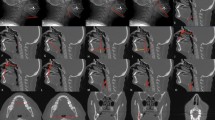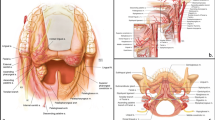Abstract
The majority of head and neck cancers arise from the oral cavity and oropharynx. Many of these lesions will be amenable to surgical resection using transoral approaches including transoral robotic surgery (TORS). To develop and control TORS tools, precise dimensions of the oral cavity and pharynx are desirable. CT angiograms of 76 patients were analyzed. For the oral cavity, only the maximum length and width were measured, while for the pharynx, the width, length, and areas of the airway were all measured and the volume calculated. A prototype TORS tool was developed and tested based on the findings and dimensions. The design modification of the tool is in progress. The mean male oral cavity width and length were 93.3 ± 4.3 and 77.0 ± 7.2 mm, respectively, and the mean male pharyngeal width, length, area, and volume were 26.5 ± 7.2 mm, 16.2 ± 8.8 mm, 325 ± 149 mm2, and 28,440 ± 14,100 mm3, respectively, while the mean female oral cavity width and length were 84.5 ± 12.9 and 71.0 ± 6.3 mm, respectively, and the mean female pharyngeal width, length, area, and volume were 24.8 ± 5.6 mm, 13.7 ± 3.2 mm, 258 ± 98 mm2, and 17,660 ± 7700 mm3, respectively. The developed TORS tool was tested inside the oral cavity of an intubation mannequin. These data will also be used to develop an electronic no-go cone-shape tunnel to improve the safety of the surgical field. Reporting the oral cavity and pharyngeal dimensions is important for design of TORS tools and creating control zones for the workspace of the tool inside the oral cavity.





Similar content being viewed by others
References
Cataloiu AD, Danciu CE, Popescu CR (2013) Multiple cancers of the head and neck. Maedica 8(1):80–85
Trottier H, Franco EL (2006) The epidemiology of genital human papillomavirus infection. Vaccine 24:S4–S15
Bledsoe T, Noble A, Hunter G et al (2013) Oropharyngeal squamous cell carcinoma with known human papillomavirus status treated with definitive chemoradiotherapy: patterns of failure and toxicity outcomes. Radiat Oncol 8:174
Weinstein GS, Quon H, O’Malley BW Jr, Kim GG, Cohen MA (2010) Selective neck dissection and deintensified postoperative radiation and chemotherapy for oropharyngeal cancer: a subset analysis of the University of Pennsylvania transoral robotic surgery trial. Laryngoscope 120:1749–1755
Liu WP, Reaugamornrat S, Deguet A, Sorger JM, Siewerdsen JH, Richmon J, Taylor RH (2013) Toward intraoperative image-guided transoral robotic surgery. J Robot Surg 7(3):217–225
Hockstein NG, O’Malley BW Jr (2008) Transoral robotic surgery. Oper Tech Otolaryngol 19:67–71
Haughey BH, Hinni ML, Salassa JR et al (2011) Transoral laser microsurgery as primary treatment for advanced-stage oropharyngeal cancer: a United States multicenter study. Head Neck 33(12):1683–1694
Sutherland GR, Wolfsberger SM, Lama S, Zareinia K (2013) The evolution of neuroArm. Neurosurgery 72(S1):A25–A32
Jan MA, Marshall I, Douglas NJ (1994) Effect of posture on upper airway dimensions in normal human. Am J Respir Crit Care Med 149(1):145–148
Iida-Kondo C, Yoshino N, Kurabayashi T, Mataki S, Hasegawa M, Kurosaki N (2006) Comparison of tongue volume/oral cavity volume ratio between obstructive sleep apnea syndrome patients and normal adults using magnetic resonance imaging. J Med Dent Sci 53(2):119–126
Kyung S, Park Y, Pae E (2005) Obstructive sleep apnea patients with the oral appliance experience pharyngeal size and shape changes in three dimensions. Angle Orthod 75(1):15–22
Honda K, Tiede MK (1998) An MRI study on the relationship between oral cavity shape and larynx position. In: Paper presented at the 5th international conference on spoken language processing, incorporating the 7th australian international speech science and technology conference; 30th November to 4th December 1998; Sydney, Australia. http://www.mirlab.org/conference_papers/International_Conference/ICSLP%201998/PDF/AUTHOR/SL980686.PDF. Accessed 26 Jan 2016
McGlone R, Proffit W (1972) Correlation between functional lingual pressure and oral cavity size. Cleft Palate Craniofac J 9:229–235
Acknowledgment
This research was conducted at Project neuroArm and was funded by the Ohlson Research Initiative and the Department of Neuroscience at the University of Calgary.
Author information
Authors and Affiliations
Corresponding author
Ethics declarations
The authors certify that they have no affiliations with or involvement in any organization or entity with any financial interest, or non-financial interest in the subject matter or materials discussed in this manuscript.
Conflict of interest
None disclosed.
Ethics approval
This study was reviewed and approved by the Conjoint Health Research Ethics Board of the University of Calgary.
Funding
This research was funded by the Ohlson Research Initiative and the Department of Neuroscience at the Cumming School of Medicine, the University of Calgary.
Rights and permissions
About this article
Cite this article
Cox, E., Ghasemloonia, A., Nakoneshny, S.C. et al. Improved transoral surgical tool design by CT measurements of the oral cavity and pharynx. J Robotic Surg 11, 179–185 (2017). https://doi.org/10.1007/s11701-016-0639-z
Received:
Accepted:
Published:
Issue Date:
DOI: https://doi.org/10.1007/s11701-016-0639-z




